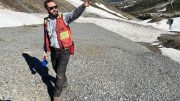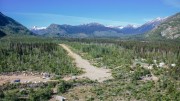REVELSTOKE, B.C. — Taranis Resources (TSXV: TRO; US-OTC: TNREF) is eyeing an option to buy 65% of FortyTwo Metals, a subsidiary of Roca Mines, in a move to secure the Max mill facility, 60 km southeast of Revelstoke, B.C.
And if it all goes according to plan, Taranis could have its Thor deposit — a precious and base metal resource 16 km by road from the mill — into production within a year-and-a-half after striking the deal.
“Aristotle said it best: ‘The whole is greater than the sum of its parts,’” John Gardiner, president and CEO of Taranis, tells The Northern Miner during a site visit to the properties. “The assets are pretty unviable on their own, but if you put the two together, it actually makes sense.”
Under the deal, Taranis will pay Roca $1.2 million along with 3 million stock warrants at 10¢ per share, exercisable for two years.
Discovery Ventures (TSXV: DVN; US-OTC: DVTMF) — a Canadian junior explorer with a base and precious metal asset, 135 km from the Max mill — will keep the remaining 35%.
Gardiner says that Discovery entered into an option to acquire the mill, but when they defaulted on the option payments last year, Taranis saw it as a “fortuitous” opportunity to step in.
“We had Roscoe Postle Associates assess the economics of the deposit alongside the existing cost data for the former Max moly mine,” he says, adding that he can’t discuss the results of the internal study. “But it looked very good, so we started talking with Roca.”
Because most of Taranis’ shareholders are directors or ex-directors of the company, Gardiner says he doesn’t expect Taranis will release any economic studies before buying FortyTwo.
But he calls the deal “a bargain,” considering it cost Roca $80 million to build the facility, which also includes a tailings dam, assay lab, office buildings and a 40-person camp. When it began operating in 2007, the mill sustained 500 tonnes per day from the Max molybdenite deposit.
Roca was making the mill amendable to operate at 1,500 tonnes per day when it was hit hard by crumbling moly prices, and placed on care and maintenance in November 2011. The firm was delisted from the TSX Venture exchange in 2013.
“The Max facility is fully amenable to process material from the Thor deposit,” Gardiner says. “In this particular case, the old saying that ‘a mine isn’t found, it’s made,’ is really true. We make things work with what we have.”
Taranis is considering a seasonal, 1,500-tonne-per-day open-pit operation for at least five years before it transitions to an underground operation. Gardiner says that once the company strikes a deal with Roca, it could have the operation going in just a year and a half.
But he says the timeline is still conservative, despite having to pay off FortyTwo’s $3-million debt load to creditors, line up a small-mines permit and go after $17 million in capital expenditures.
“Permits are the critical piece of the timeline,” he admits. “But the Thor deposit lies entirely on Crown Grant mineral claims that were issued in the late 1800s, and these only help accelerate the process.”
To cover costs, Gardiner says the company will pursue debt financing, and he expects to pay off the loan “in the first year of production.” He adds that FortyTwo also holds an attractive $50 million in accumulated tax pools that will help shelter production revenue in the coming years.
The Thor deposit has been intermittently explored and modestly mined as a vein-hosted, polymetallic deposit from the turn of the 19th century to the mid-1980s.
But when Gardiner first walked the ground in 2006, he recognized it as a deformed volcanogenic massive sulphide (VMS) deposit that could be traced along a single horizon in the stratigraphy for at least 2 km.
“If it was just a vein we wouldn’t be interested, because we knew it’d have limited size,” he says. “And when we saw it as a VMS, we knew it was worth something. All it took was the right pair of eyes.”
The low-hanging fruit at Thor would attract any aspiring miner: the deposit forms a reddened, gossanous crust along the flank of the mountain. Chiseled into its face are the adits and channels from Thor’s predecessors, and broken, massive sulphides with quartz are piled on top of everything but the road.
The exposures made the maiden resource drill-out easy in 2007, when Taranis lined up its first drill hole.
The work established a resource within an array of five, tabular-shaped deposits along a sedimentary contact between carbonaceous shales and overlying greywackes.
Indicated resources include 640,000 tonnes at 0.88 gram gold per tonne, 187 grams silver, 0.1% copper, 2.5% lead and 3.5% zinc, and inferred resources add up to 424,000 tonnes of 0.98 gram gold, 176 grams silver, 0.1% copper, 2.3% lead and 3.2% zinc. Sixty-two percent of the resource is open-pittable.
Gardiner points out that resource drilling occurred on a small piece of a much larger whole. Between the shuffled deposits is the gold- and silver-enriched Scab zone that isn’t part of the current resource. The target is a 1- to 4-metre thick zone of massive sulphide that similarly flanks the side of the mountain across a 300-by-200-metre area.
But despite the easy pickings on surface, Gardiner says there’s big underground potential as well.
“Because the old timers thought it was a vein, they didn’t look on the other side of the anticline,” he says, explaining how the rocks that form the dip slope in the east fold over and plunge beneath the mountain in the west.
“We found some heavily mineralized float along a 200-metre geophysical anomaly, and trenching in 2014 revealed some high-grade gold and silver mineralization, so we know the deposit continues.”
But the outcrop that headlines conversation is the spine of milky white quartz at the top of the interpreted anticline that Gardiner claims is teeming with gold.
The structurally controlled deposit, called SIF, is another notch in Taranis’ legacy of discoveries on the property. Panel sampling in 2014 returned 30.6 grams gold over 17.6 metres, and outlined high-grade gold mineralization over at least 30 metres of strike length.
“Historically the main emphasis at Thor was the silver, but we are finding a lot more gold and this really kick-starts the economics, and pays back the capex costs quickly,” he adds, chipping away at the outcrop and handing over a visible gold sample within a vug of quartz.
Taranis and Roca could reach an agreement by the end of August.
“Roca did a super job at building this,” he says, adding that it is a “top notch” facility. “All the pieces are here, so all we have left to do is glue them together.”
Taranis has traded within a 52-week window of 3¢ to 15¢, and closed at 4¢ at press time. The company has 45.8 million shares outstanding for a $1.83-million market capitalization.





Be the first to comment on "Site visit: Taranis hopes to take Thor to the Max"